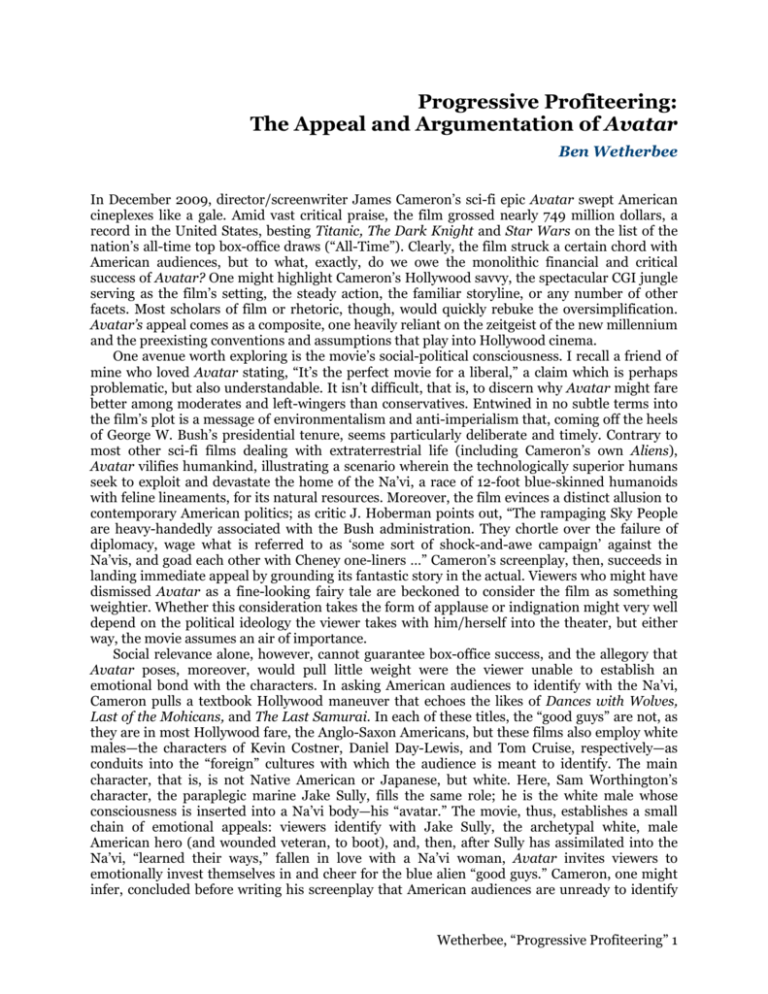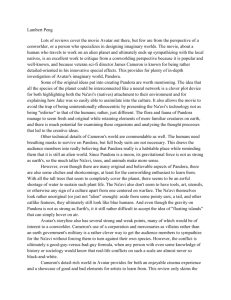Progressive Profiteering: The Appeal and Ideology of Avatar
advertisement

Progressive Profiteering: The Appeal and Argumentation of Avatar Ben Wetherbee In December 2009, director/screenwriter James Cameron’s sci-fi epic Avatar swept American cineplexes like a gale. Amid vast critical praise, the film grossed nearly 749 million dollars, a record in the United States, besting Titanic, The Dark Knight and Star Wars on the list of the nation’s all-time top box-office draws (“All-Time”). Clearly, the film struck a certain chord with American audiences, but to what, exactly, do we owe the monolithic financial and critical success of Avatar? One might highlight Cameron’s Hollywood savvy, the spectacular CGI jungle serving as the film’s setting, the steady action, the familiar storyline, or any number of other facets. Most scholars of film or rhetoric, though, would quickly rebuke the oversimplification. Avatar’s appeal comes as a composite, one heavily reliant on the zeitgeist of the new millennium and the preexisting conventions and assumptions that play into Hollywood cinema. One avenue worth exploring is the movie’s social-political consciousness. I recall a friend of mine who loved Avatar stating, “It’s the perfect movie for a liberal,” a claim which is perhaps problematic, but also understandable. It isn’t difficult, that is, to discern why Avatar might fare better among moderates and left-wingers than conservatives. Entwined in no subtle terms into the film’s plot is a message of environmentalism and anti-imperialism that, coming off the heels of George W. Bush’s presidential tenure, seems particularly deliberate and timely. Contrary to most other sci-fi films dealing with extraterrestrial life (including Cameron’s own Aliens), Avatar vilifies humankind, illustrating a scenario wherein the technologically superior humans seek to exploit and devastate the home of the Na’vi, a race of 12-foot blue-skinned humanoids with feline lineaments, for its natural resources. Moreover, the film evinces a distinct allusion to contemporary American politics; as critic J. Hoberman points out, “The rampaging Sky People are heavy-handedly associated with the Bush administration. They chortle over the failure of diplomacy, wage what is referred to as ‘some sort of shock-and-awe campaign’ against the Na’vis, and goad each other with Cheney one-liners …” Cameron’s screenplay, then, succeeds in landing immediate appeal by grounding its fantastic story in the actual. Viewers who might have dismissed Avatar as a fine-looking fairy tale are beckoned to consider the film as something weightier. Whether this consideration takes the form of applause or indignation might very well depend on the political ideology the viewer takes with him/herself into the theater, but either way, the movie assumes an air of importance. Social relevance alone, however, cannot guarantee box-office success, and the allegory that Avatar poses, moreover, would pull little weight were the viewer unable to establish an emotional bond with the characters. In asking American audiences to identify with the Na’vi, Cameron pulls a textbook Hollywood maneuver that echoes the likes of Dances with Wolves, Last of the Mohicans, and The Last Samurai. In each of these titles, the “good guys” are not, as they are in most Hollywood fare, the Anglo-Saxon Americans, but these films also employ white males—the characters of Kevin Costner, Daniel Day-Lewis, and Tom Cruise, respectively—as conduits into the “foreign” cultures with which the audience is meant to identify. The main character, that is, is not Native American or Japanese, but white. Here, Sam Worthington’s character, the paraplegic marine Jake Sully, fills the same role; he is the white male whose consciousness is inserted into a Na’vi body—his “avatar.” The movie, thus, establishes a small chain of emotional appeals: viewers identify with Jake Sully, the archetypal white, male American hero (and wounded veteran, to boot), and, then, after Sully has assimilated into the Na’vi, “learned their ways,” fallen in love with a Na’vi woman, Avatar invites viewers to emotionally invest themselves in and cheer for the blue alien “good guys.” Cameron, one might infer, concluded before writing his screenplay that American audiences are unready to identify Wetherbee, “Progressive Profiteering” 1 with a group of non-white (indeed, non-human, here) “others” without a “normal” protagonist to introduce the group. While technically non-human, though, the Na’vi are hardly unfamiliar to American audiences. Their culture comprises a cliché-heavy amalgam of Native American philosophies and religious tenets—or simplistic pop-cultural perversions thereof—that abound in other Hollywood films, Dances with Wolves, and Last of the Mohicans included, that attempt to treat Native Americans sympathetically. The artificial culture Hollywood concocts for these natives incorporates such teachings and assumptions as, “One should only kill out of need,” “One finds happiness in simplicity,” “God—or ‘The Great Spirit’—is found in nature,” and, in turn, “Happiness, harmony, and truth lie in oneness with nature.” The consequential representation is that of a simple, self-sustaining, and naïve people who are, barring the azure skin and catlike features, the splitting image of the Na’vi. These aforesaid beliefs are those exactly of the Na’vi, and these alien natives even speak and dress just like stereotypical Hollywood Native Americans. Their chief, to cap off the comparison, is played and voiced by Wes Studi, a fullblooded Cherokee. Such Native American pseudo-culture and its assumed wisdom becomes the scaffold upon which Cameron hangs his environmentalist argument. It is interesting to note, here, the lack of a renowned star—a Tom Cruise or Daniel Day-Lewis—to fill Avatar’s primary role. Worthington, like most of the film’s actors, is a B-list Hollywood name; Sigourney Weaver is the only exception, playing an important but decidedly secondary role. Avatar’s “star,” then, its true selling point, is not the cast but the CGI world, Pandora—complete with sky-eclipsing foliage, trees 40 stories high, phosphorescent airborne jellyfish, dragons, and floating rocks—where Cameron sets the film. Drowning in this ceaseless computer-rendered spectacle, the viewer is meant to develop an awe-induced emotional connection to Pandora, whose beauty towers above and beyond the run-of-the-mill screenplay and performances. The logic that the movie creates, furthermore, reaffirms that true power comes from oneness with nature. Only by praying to Eywa, the Na’vi’s equivalent of “The Great Spirit,” is Sully able to harness Pandora’s natural power on behalf of the Na’vi and defeat the rampaging humans. Nature trumps technology, the argument goes. Here, however, enters Avatar’s calculated logical contradiction. The movie’s explosively violent final act implies what most action films do (i.e. the Rambo and Lethal Weapon franchises), that real results, ultimately, come only from manning up and settling matters through armed conflict. This macho, right-wing truism, popular among American film audiences, appears most transparently in the climactic final battle, wherein Sully expresses unequivocal joy at the chance to fight and kill the merciless colonel who had been his superior officer. The movie glorifies this moment, even as it gainsays the Na’vi wisdom that killing should be only an affair of sad necessity. In its finale, Avatar does not bemoan the violence it presents. The violence is meant to be fun. As audiences uncritically tag along on this final explosive ride, moreover, they accept its logic; they accept the “git-‘er-done” attitude that values decisive, violent action, and rebukes diplomacy and dialogue. In discussing Avatar’s appeal, however, such contradiction may be unimportant. The movie exploits its conflicting arguments for different purposes: the cultural teachings that Hollywood fabricates for its Native Americans and the Na’vi, on one hand, serves the purpose of making Avatar a “serious” film with “something to say” about the real-world issues of environmental destruction and the American propensity to meddle with cultures it doesn’t understand. Appeal to the beliefs of the Na’vi, indeed, doubles as an appeal to the character of Native American wisdom. The second set of arguments—the “any means necessary” attitude of valorized militarism—satisfies the simple expectation of fighting, explosions, and a decisively happy ending that American audiences bring to a sci-fi epic. While logically these arguments do not add up, a quick glance toward Avatar’s box-office numbers, and toward the enthusiasm that buzzed around its theatrical and DVD releases, indicates that financially they do. Wetherbee, “Progressive Profiteering” 2 Works Cited “All-Time Box Office: USA.” The Internet Movie Database. 25 May 2010. Web. 27 May 2010. Avatar. Dir. James Cameron. Perf. Sam Worthington, Sigourney Weaver. Twentieth Century Fox, 2009. Film. Hoberman, J. “Avatar’s Sticker Shock (and Awe).” The Village Voice. 15 Dec. 2009. Web. 1 June 2010. Wetherbee, “Progressive Profiteering” 3







